Saturday, August 26, 2006
Galapagos Islands 'face species threat'
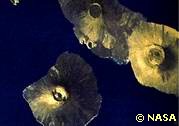 BBC News: Officials in Ecuador say they are worried about the discovery of foreign species on the Galapagos Islands.
BBC News: Officials in Ecuador say they are worried about the discovery of foreign species on the Galapagos Islands.
Despite inspections of incoming ships and planes, local people recently found an iguana and a turtle which probably came from mainland South America.
Invasive foreign species are one of the main threats to the islands' wildlife.
This includes giant tortoises, marine iguanas and finches which enchanted naturalist Charles Darwin and helped him develop his theory of evolution.
It is the isolation of the Galapagos Islands which makes their ecology unique. [Ecuador, invasion]
technorati tags: ecuador, discovery, foreign, species, galapagos, islands, iguana, turtle, mainland, south+america, wildlife, giant, tortoises, marine, iguanas, finches, charles, darwin, theory, evolution, isolation, ecology, archipelago, invasion, bbc, news
Add to: CiteUlike | Connotea | Del.icio.us | Digg | Furl | Newsvine | Reddit | Yahoo
Instant Expert: Human Evolution
A Key Topic Report from New Scientist: The incredible story of our evolution from ape ancestors spans 6 million years or more, and features the acquirement of traits from bipedal walking, large brains, hairlessness, tool-making, hunting and harnessing fire, to the more recent development of language, art, culture and civilisation.
Darwin's The Origin of Species, published in 1859, suggested that humans were descended from African apes. However, no fossils of our ancestors were discovered in Africa until 1924, when Raymond Dart dug up the 'Taung child' - a 3-million to 4 million-year-old Australopithecine.
Over the last century, many spectacular discoveries have shed light on the history of the human family. Somewhere between 12 and 19 different species of early humans are recognised, though palaeoanthropologists bitterly dispute how they are related. Famous fossils include the remarkably complete 'Lucy', dug up in Ethiopia in 1974, and the astonishing 'hobbit' species, Homo floresiensis, found on an Indonesian island in 2004.
technorati tags: evolution, ape, ancestors, traits, bipedal, walking, brains, tool-making, hunting, fire, language, art, culture, civilization, darwin, origin, species, african, fossils, taung, child, history, human, species, lucy, ethiopia, hobbit, homo+floresiensis, new+scientist
Add to: CiteUlike | Connotea | Del.icio.us | Digg | Furl | Newsvine | Reddit | Yahoo
Insect predation sheds light on food web recovery after the dinosaur extinction
 The recovery of biodiversity after the end-Cretaceous mass extinction was much more chaotic than previously thought, according to paleontologists. New fossil evidence shows that at certain times and places, plant and insect diversity were severely out of balance, not linked as they are today. The extinction took place 65.5 million years ago. Labeled the K-T extinction, it marks the beginning of the Cenozoic Era and the Paleocene Epoch.
The recovery of biodiversity after the end-Cretaceous mass extinction was much more chaotic than previously thought, according to paleontologists. New fossil evidence shows that at certain times and places, plant and insect diversity were severely out of balance, not linked as they are today. The extinction took place 65.5 million years ago. Labeled the K-T extinction, it marks the beginning of the Cenozoic Era and the Paleocene Epoch.
'The K-T caused major extinction among North American plants and insects. The Western Interior U.S. was a dead zone for plants and plant-insect food webs,' said Dr. Peter Wilf, assistant professor of geosciences and the David and Lucile Packard Fellow. 'We know that right after the extinction, for 800,000 years, there was very low insect predation and plant diversity. We know that 9 million years afterwards, there was renewed diversity in both plants and insects. What happened in the 8 million years in between?
'In modern forests, insect diversity tracks plant populations. If there are few plants, there are few insects, and that is what we expected to see and mostly found throughout the 10-million-year Paleocene. However, we looked extremely hard to test this conventional wisdom and found some shocking exceptions that have given us new ideas about how food webs recover from mass extinction,' he added.
--
The above news release is based on the Science report "Decoupled Plant and Insect Diversity After the End-Cretaceous Extinction" (Abstract)
technorati tags: biodiversity, cretaceous, mass, extinction, recovery, fossil, evidence, plants, insects, diversity, k-t, cenozoic, paleocene, epoch, north+american, u.s., forests, modern, populations, food, webs
Add to: CiteUlike | Connotea | Del.icio.us | Digg | Furl | Newsvine | Reddit | Yahoo
Friday, August 25, 2006
A wandering eye: Single cells come running to form an eye
Eyes are among the earliest recognisable structures in an embryo; they start off as bulges on the sides of tube-shaped tissue that will eventually become the brain. Researchers from the European Molecular Biology Laboratory (EMBL) in Heidelberg have now discovered that cells are programmed to make eyes early in development and individually migrate to the right place to do so. The study, published in this week's issue of the journal Science, overturns the textbook model of the process and suggests that also other organs might be formed by the movement of single cells rather than sheets of entire tissues.
Jochen Wittbrodt and his lab at EMBL made the discovery using advanced microscope techniques to track individual cells in the transparent embryos of a small fish called Medaka.
'You can think of the tube as a deflated balloon shaped like a Mickey Mouse,' Wittbrodt says. 'As the fish grows, the eyes gradually bulge out from the tube, the way Mickey Mouse ears expand as a balloon is filled with air. Most scientists have thought that cells in the neighbouring regions grow to make the bulges. What we've seen is that individual cells migrate to this area from the central region of the tube – as if to make ears, tiny rubber particles had to fly out from the air inside the balloon.'
--
The above is based on the Science report "Individual Cell Migration Serves as the Driving Force for Optic Vesicle Evagination" (Abstract)
technorati tags: eyes, embryo, brain, molecular, biology, laboratory, embl, heidelberg, cells, development, migrate, journal, science, single, advanced, microscope, techniques, fish, medaka, mickey, mouse, ears, optic, vesicle
Add to: CiteUlike | Connotea | Del.icio.us | Digg | Furl | Newsvine | Reddit | Yahoo
China - Diplodocus fossils found in Ningxia
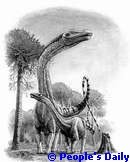 Chinese archaeologists have reported major dinosaur findings in northwest China's Ningxia Hui and Xinjiang Uygur autonomous regions. In Lingwu excavation site of Ningxia, they spotted fossils of diplodocus species that had never been unearthed in Asia before. In Changji excavation site of Xinjiang, it is possible for them to find the fossils of a whole large-size dinosaur skull, possibly a Asian record dinosaur fossil in terms of size.
Chinese archaeologists have reported major dinosaur findings in northwest China's Ningxia Hui and Xinjiang Uygur autonomous regions. In Lingwu excavation site of Ningxia, they spotted fossils of diplodocus species that had never been unearthed in Asia before. In Changji excavation site of Xinjiang, it is possible for them to find the fossils of a whole large-size dinosaur skull, possibly a Asian record dinosaur fossil in terms of size.
Xu Xing, a researcher of the Ancient Vertebrates and Ancient Human Research Institute under the Chinese Academy of Sciences (CAS), who takes charge of the excavation, cited diplodocus as the biggest of its kind among a group of giant plant-eating dinosaurs and the longest animal inhabiting on land since the dawn of history, namely, living in the late Jurassic and early Cretaceous periods approximately 150 million years ago. Despite its mammoth body, it has a small head, with nostrils growing on top of the head.
technorati tags: chinese, dinosaur, china, ningxia, hui, xinjiang, uygur, lingwu, diplodocus, species, asia, changji, fossils, skull, ancient, vertebrates, human, research, institute, academy, sciences, excavation, jurassic, cretaceous, mammoth
Add to: CiteUlike | Connotea | Del.icio.us | Digg | Furl | Newsvine | Reddit | Yahoo
Rabbi defends show linking Darwin, Hitler ('Darwin's Deadly Legacy')
Charles Darwin should share with Hitler the blame for the 11 million or more lives lost in the Holocaust, a new television special explains. And, the program says, the more than 45 million American lives lost to abortion also can be blamed on that famous founder of evolutionary theory.
"This show basically is about the social effects of Darwinism, and shows this idea, which is scientifically bankrupt, has probably been responsible for more bloodshed than anything else in the history of humanity," Jerry Newcomb, one of two co-producers, told WorldNetDaily.
Author and Christian broadcaster D. James Kennedy said the new "Darwin's Deadly Legacy," is a ground-breaking inquiry into Darwin's "chilling" social impact, and it will air nationwide on Aug. 26-27 on "The Coral Ridge Hour" - more info here. [evolution, intelligent design, ministries]
A 5 minute (approx) preview of the program is also available: DSL | ISDN | MODEM
In an update to last Saturday's entry of "Show links Darwin, Hitler ideologies: Holocaust was fallout of evolution theory, says new production" (quoted above) The World Net Daily reports:
A rabbi has launched a defense of D. James Kennedy, whose new television special this weekend will raise an alarm about the bloodshed credited to the influence of Darwin's theories of evolution, and has been attacked because of its message.
The program is "Darwin's Deadly Legacy", a Coral Ridge Ministries production featuring more than a dozen experts in various fields talking about the connections between Darwin's theories, eugenics, Hitler and abortion.
Its premise is that Darwin's thinking changed the world's perception of people, so instead of considering them made in God's image, they became just another organism. Bloggers Internet-wide as well as the Anti-Defamation League launched their criticism in pointed phrases when the airing was announced.
But Rabbi Daniel Lapin, founder of Toward Tradition, suggested reining in the words just a little: "Rabbi defends show linking Darwin, Hitler"
technorati tags: charles, darwin, hitler, holocaust, abortion, preview, evolutionary, theory, darwinism, history, humanity, christian, coral+ridge, evolution, intelligent+design, deadly, legacy, darwin's, ministries, rabbi, world, net, daily, kennedy, television, eugenics, bloggers, internet, anti-defamation, league, toward, tradition, experts
Add to: CiteUlike | Connotea | Del.icio.us | Digg | Furl | Newsvine | Reddit | Yahoo
How modern were European Neanderthals?
 Neandertals were much more like modern humans than had been previously thought, according to a re-examination of finds from one of the most famous palaeolithic sites in Europe by Bristol University archaeologist, Professor Joao Zilhao, and his French colleagues.
Neandertals were much more like modern humans than had been previously thought, according to a re-examination of finds from one of the most famous palaeolithic sites in Europe by Bristol University archaeologist, Professor Joao Zilhao, and his French colleagues.
Professor Zilhao has been able to show that sophisticated artefacts such as decorated bone points and personal ornaments found in the Chatelperronian culture of France and Spain were genuinely associated with Neandertals around 44,000 years ago, rather than acquired from modern humans who might have been living nearby. His findings are published in the Proceedings of the National Academy of Sciences (PNAS) USA.
The site from which this Neandertal culture derives its name is the Grotte de Fees at Chatelperronian in Central France, first excavated in the 1840s. It has been one of the most important and controversial places to understand how modern humans that had previously moved out of Africa replaced the Neandertals, often portrayed as more 'primitive'.
--------
This news release is based on the paper "Analysis of Aurignacian interstratification at the Chatelperronian-type site and implications for the behavioral modernity of Neandertals" (Abstract)
[Neanderthal, Châtelperronian, Fées]
Books on Neanderthals from the Science and Evolution Bookshop: UK | US
Books on Human Origins from the Science and Evolution Bookshop: UK | US
technorati tags: neandertal, neanderthal, modern, humans, palaeolithic, europe, bristol, university, artefacts, bone, ornaments, france, spain, africa, primitive
Add to: CiteUlike | Connotea | Del.icio.us | Digg | Furl | Newsvine | Reddit | Yahoo
Thursday, August 24, 2006
US Department of Education 'overlooks' evolution
The New Scientist: Evolutionary biology is mysteriously missing from the list of undergraduate subjects eligible for a US federal grant.
The department of education claims the omission is simply a mistake and insists that US students taking evolutionary biology majors are eligible for the grants. However, the incident has left pro-evolution campaigners wondering whether evolutionary biology was deliberately eliminated from the list by people who find Darwinian evolution impossible to reconcile with their own religious beliefs.
"I have reason to believe there is a serious problem here," physicist Lawrence Krauss of Case Western Reserve University in Cleveland, Ohio, told New Scientist.
technorati tags: new, scientist, evolutionary, biology, missing, undergraduate, subjects, us, federal, grant, department, education, omission, students, evolution, darwinian, religious, beliefs, case, western, reserve, university, cleveland, ohio
Add to: CiteUlike | Connotea | Del.icio.us | Digg | Furl | Newsvine | Reddit | Yahoo
New Definition of 'Species' Could Aid Species Identification
Scientists at Texas Tech University argue that defining mammalian species based on genetics will result in the recognition of many more species than previously thought present. This has profound implications for our knowledge of biodiversity and issues based on it, such as conservation, ecology, and understanding evolution. Their study is published in the latest Journal of Mammalogy.
The classical definition of species was proposed by Ernst Mayr in 1942, defining it as reproductively isolated groups of organisms. According to this study, the problem with applying this concept is that it is hard to observe mating and to know whether there is interbreeding between populations and thus creation of hybrid species. Traditionally, species have been recognized based on physical characteristics, although it has been assumed that species differences are inherited and thereby reflect genetic differences.
Study researchers Robert Baker and Robert Bradley define "species" based on genetic data.
--
The above news release is based on the paper "Speciation in mammals and the genetic species concept"
technorati tags: texas, tech, university, mammalian, species, genetics, biodiversity, conservation, ecology, evolution, journal, mammalogy, ernst, mayr, organisms, populations, hybrid, interbreeding, physical, characteristics, inherited, genetic, data, speciation, mammals, concept
Add to: CiteUlike | Connotea | Del.icio.us | Digg | Furl | Newsvine | Reddit | Yahoo
Students Face New Learning Standards (General Interest)
The Washington Post: Students returning to school Monday will get the first taste of the D.C. (District of Columbia) school system's new science and social studies learning standards, which are aimed at immediately introducing more rigor into the classroom and ultimately new textbooks, standardized tests and even upgraded science labs.
The learning standards, outlining what students should know and be able to do at each grade level, are among many new policies and initiatives slated to be launched this year. The changes, school officials say, are intended to boost student achievement, increase the level of parental involvement in the schools and improve efficiency for teachers and administrators.
...The new science standards, modeled on those from Indiana, will focus more on experiments and hands-on learning, replacing the existing standards that emphasize book learning. The new science standards, according to school officials, will not teach creationism.
technorati tags: washington, post, students, school, district, columbia, science, social, studies, learning, standards, classroom, textbooks, tests, science, labs, indiana, experiments, creationism
Add to: CiteUlike | Connotea | Del.icio.us | Digg | Furl | Newsvine | Reddit | Yahoo
Austrian cardinal says Darwinism should be studied as science
Rimini, Italy (CNS) - Austrian Cardinal Christoph Schonborn of Vienna said he thought Darwin's theories on evolution deserve to be studied in schools, along with the scientific question marks that remain.
It is right to teach 'the science of Darwin, not ideological Darwinism,' Cardinal Schonborn said Aug. 23. He spoke at a meeting in Rimini sponsored by the Catholic lay movement Communion and Liberation, and his remarks were reported by Italian newspapers.
In 2005, Cardinal Schonborn helped fuel the debate over evolution and intelligent design when he wrote in The New York Times that science offers 'overwhelming evidence for design in biology.' He later said some scientists had turned Darwin's teachings into an ideological 'dogma' that admitted no possibility of a divine design in the created world." [Catholic News Service]
technorati tags: rimini, italy, cns, austrian, cardinal, schonborn, vienna, darwin, evolution, science, darwinism, communion, liberation, intelligent+design, new+york+times, biology, dogma, divine, catholic, news, service
Add to: CiteUlike | Connotea | Del.icio.us | Digg | Furl | Newsvine | Reddit | Yahoo
Evolution of primate gene expression (Nature Reviews Genetics)
It has been suggested that evolutionary changes in gene expression account for most phenotypic differences between species, in particular between humans and apes. What general rules can be described governing expression evolution? We find that a neutral model where negative selection and divergence time are the major factors is a useful null hypothesis for both transcriptome and genome evolution. Two tissues that stand out with regard to gene expression are the testes, where positive selection has exerted a substantial influence in both humans and chimpanzees, and the brain, where gene expression has changed less than in other organs but acceleration might have occurred in human ancestors.
Nature Reviews Genetics 7, 693-702 (September 2006) | doi:10.1038/nrg1940
Evolution of primate gene expression: Abstract | Full Text | Pdf
Philipp Khaitovich, Wolfgang Enard, Michael Lachmann and Svante Paabo
Books on Neanderthals from the Science and Evolution Bookshop: UK | US
Books on Human Origins from the Science and Evolution Bookshop: UK | US
technorati tags: evolutionary, changes, gene, expression, phenotypic, differences, species, humans, apes, evolution, neutral, model, negative, selection, null, hypothesis, genome, testes, brain, ancestors
Add to: CiteUlike | Connotea | Del.icio.us | Digg | Furl | Newsvine | Reddit | Yahoo
The joys of life without God (Interview)
Skeptics Society founder Michael Shermer explains why Darwin matters, how believing in God is the same as believing in astrology, and why it doesn't take divine faith to experience something bigger than ourselves:
Aug. 23, 2006: Michael Shermer has done a fine job in his new book ('Why Darwin Matters: The Case Against Intelligent Design') of letting the air out of intelligent design's tires. As you recall, the so-called scientific movement, which says that nifty things in the universe, like human eyes, are so perfect they couldn't possibly have been created by the crude steps of evolution, was rolling along quite nicely through school districts last year, kicking up a chorus of hallelujahs from creationists. Some of Shermer's ivory towerish science pals, like Richard Dawkins and the late Stephen Jay Gould, told him not to bother with the I.D. boosters, that acknowledging them meant going along for their political ride, where the integrity of science was being run into the ground.
But true to his genial nature, Shermer ignored his friends' advice and penned 'Why Darwin Matters: The Case Against Intelligent Design' With admirable patience and humility, he spells out each of the fancy I.D. tenets, like 'design inference,' in which only a higher intelligence could have come up with something as cool and ingenious as DNA. Shermer shows how imperfect evolution, and not intelligent design, has been, for generations, the only quantifiable driver behind nature's wonders."
--
[Reading the whole article requires clicking on a 'sponsor' link - I had to disable Firefox's 'Adblock' first]
Why Darwin Matters: The Case Against Intelligent Design can be obtained from Amazon: UK | US
technorati tags: intelligent+design, universe, eyes, human, evolution, michael, shermer, school, creationists, richard, dawkins, stephen, jay, gould, i.d., design, inference, intelligence, nature, skeptics, society, god, astrology, divine, faith
Add to: CiteUlike | Connotea | Del.icio.us | Digg | Furl | Newsvine | Reddit | Yahoo
Wednesday, August 23, 2006
Re: Homo floresiensis - 'No Hobbits in this Shire' (Posted 21st August, 2006)
The PNAS open access paper referred to in the news release quoted below is now available:
"Pygmoid Australomelanesian Homo sapiens skeletal remains from Liang Bua, Flores: Population affinities and pathological abnormalities"
Homo floresiensis - 'No Hobbits in this Shire'
University Park, Pennsylvania - The skeletal remains found in a cave on the island of Flores, Indonesia, reported in 2004, do not represent a new species ('Homo floresiensis') as then claimed but are some of the ancestors of modern human pygmies who live on the island today, according to an international scientific team.
The researchers also demonstrate that the fairly complete skeleton designated LB1 is microcephalic, while other remains excavated from the site share LB1's small stature but show no evidence of microcephaly, since no other brain cases are known. Microcephaly is a condition in which the head and brain are much smaller than average for the person's age and gender. It can be present at birth or develop afterwards and is associated with a complex of other growth and skeletal anomalies.
..Jacob and colleagues found four major areas of evidence where the 2004 evaluation was wrong: geographical factors, craniofacial asymmetry, dental traits and postcranial abnormalities. They discuss these areas in today's (Aug. 21) online edition of the Proceedings of the National Academy of Sciences (PNAS - Astract not yet available).
technorati tags: Homo+floresiensis, cave, island, flores, indonesia, species, modern, human, pygmies, skeleton, microcephaly, brain, evidence, asymmetry, dental, traits, abnormalities, proceedings, national, academy, sciences, pnas
Add to: CiteUlike | Connotea | Del.icio.us | Digg | Furl | Newsvine | Reddit | Yahoo
Archaea: Revealing the earth's secrets
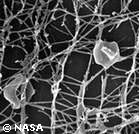 In biology textbooks the world over you can read about how important bacteria in the soil are for plants and animals. Now the textbooks might have to be rewritten.
In biology textbooks the world over you can read about how important bacteria in the soil are for plants and animals. Now the textbooks might have to be rewritten.
The textbooks tell us namely that there are two types of nitrifying bacteria which account for all the oxidisation of ammonia (NH3) into nitrite (NO2) and subsequently into nitrate (NO3). It turns out that these bacteria are probably much less important in the nitrogen cycle than previously assumed. Instead, it appears that most of this job may be done by a completely different type of micro-organism: archaea.
Professor Christa Schleper of the Department of Biology at the University of Bergen, Norway, is a specialist in archaea, and she is behind this discovery, which may prove expensive for the textbook publishers. A lot of research remains to be done, however - archaea is namely a type of organism about which little has so far been known.
--
The above is based on the 'Letter to Nature' "Archaea predominate among ammonia-oxidizing prokaryotes in soils".
At the time of writing both the Summary and Full Text (via link on the Summary page) are available.
technorati tags: biology, textbooks, bacteria, soil, plants, ammonia, nitrite, nitrate, nitrogen, cycle, micro-organism, archaea, university, bergen, norway, discovery, nature, prokaryotes
Add to: CiteUlike | Connotea | Del.icio.us | Digg | Furl | Newsvine | Reddit | Yahoo
Tuesday, August 22, 2006
In 'Malibu,' survival of the wittiest (Theatre Review of 'Darwin in Mailbu')
Review: It's easy to imagine Charles Darwin spinning in his grave as Creationism, in the guise of Intelligent Design, rises up to challenge his theory of evolution once again. A little too easy.
Playwright Crispin Whittell doesn't tarry long on that easy route to 'Darwin in Malibu.' Although Gary Hygom's shingled, earth-tone set for the U.S. premiere at Bay Street Theatre re-creates an oceanfront deck that suggests the Hamptons, the shirt Hal Linden sports in his role of Charles Darwin gives him away as a Malibu tourist. What's drawn him to the West Coast is uncertain: perhaps a girl, Sarah (Anna Chlumsky), who kisses him chastely on the cheek and serves him a banana smoothie, or his fascination with faults - the geologic sort that cause earthquakes as devastating as the one that jolted religion upon publication of his 'The Origin of Species' in 1859.
Soon enough, we learn that he's here to rehash the famous meeting of the British Association at Oxford, England, in which Thomas Huxley (Neal Huff) debated Bishop Samuel Wilberforce.
technorati tags: charles, darwin, creationism, intelligent+design, theory, evolution, playwright, malibu, premiere, bay, street, theatre, tourist, west+coast, origin, species, religion, publication, british, association, oxford, england, huxley, thomas, bishop, samuel, wilberforce, review
Add to: CiteUlike | Connotea | Del.icio.us | Digg | Furl | Newsvine | Reddit | Yahoo
US: Paleontologists dig deeper in Marshall County (Mastodon)
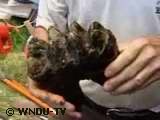 Paleontologists from the Indiana State Museum climbed into a Marshall County pit on Monday, on a journey thousands of years back in time.
Paleontologists from the Indiana State Museum climbed into a Marshall County pit on Monday, on a journey thousands of years back in time.
They are looking for remains of a prehistoric, hairy elephant... the mastodon.
Earlier this afternoon, the mastodon discovery was verified.
An enormous tooth was found letting searchers know that the mastodon likely died in the field up to 14,000 years ago.
--
The above news report contains video footage.
Also see "Ice-age tusk surfaces in clay of fossil-rich Saltville Valley" (Virginia)
technorati tags: indiana, state, museum, prehistoric, elephant, mastodon, tooth, marshall, county, tusk, saltville, virginia, video
Add to: CiteUlike | Connotea | Del.icio.us | Digg | Furl | Newsvine | Reddit | Yahoo
Male-killing bacteria foiled by butterfly gene
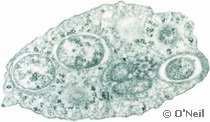 A bacterium that slaughters all the male offspring of the insects it infects has been disarmed by a simple genetic change in a butterfly host within a few decades.
A bacterium that slaughters all the male offspring of the insects it infects has been disarmed by a simple genetic change in a butterfly host within a few decades.
The speed with which this resistance evolved implies that male-killing may have appeared - and disappeared again - much more commonly than previously suspected.
The male-killing bacterium is a strain of Wolbachia, a widespread group of bacteria that are passed from one generation of hosts to the next in eggs, but not sperm.
Since males represent a "dead-end" for the bacteria, they have evolved a variety of tricks to favour females in their hosts, including converting males into females, inducing females to bear only female offspring and, rarely, simply killing male embryos.
--
The above news release is based on the PLoS Biology open access paper "Evolution of Male-Killer Suppression in a Natural Population"
technorati tags: bacterium, males, offspring, genetic, change, butterfly, host, resistance, bacteria, eggs, sperm, females, embryos, killer, plos, biology, evolution, population, male
Add to: CiteUlike | Connotea | Del.icio.us | Digg | Furl | Newsvine | Reddit | Yahoo
Ant jaws break speed record, propel insects into air, biologists find
A species of ant native to Central and South America is entering the annals of extreme animal movement, boasting jaws arguably more impressive than such noteworthy contenders as the great white shark and the spotted hyena.
Biologists clocked the speed at which the trap-jaw ant, Odontomachus bauri, closes its mandibles at 35 to 64 meters per second, or 78 to 145 miles per hour - an action they say is the fastest self-powered predatory strike in the animal kingdom. The average duration of a strike was a mere 0.13 milliseconds, or 2,300 times faster than the blink of an eye...
...O. bauri appears to be rather unusual among trap-jaw ants in that it definitely uses its jaws for functions other than prey capture, namely defense," said Suarez. "It remains to be seen if other trap-jaw ants have co-opted their high speed mandibles for other purposes."
While many examples of multi-functionality exist among other animals - bird feathers are used for both heat regulation and flight, for example - the researchers note that the spring-latch system for the jaws has evolved a remarkable four times in ants, at least, and perhaps twice in evolutionary history has the system been used for propulsion. These multiple independent origins of such structures - a rare occurrence in evolution - offer insights into how novel behaviors may evolve in biology...
--
The above Berkeley news release is based on a Proceedings of the National Academy of Sciences paper (PNAS) "Multifunctionality and mechanical origins: Ballistic jaw propulsion in trap-jaw ants": Abstract
The news release contains a link to two short videos ('Escape Jump' and 'Mandible Strike') which are directly accessible here (requires Quicktime 7.1)
The Washington Post's 'Science Notebook' also carries a report: "Trap-Jaw Ant's Bite Sets Record"
technorati tags: species, ant, central, south, america, animal, movement, jaws, great, white, shark, spotted, hyena, trap-jaw, speed, kingdom, strike, jaws, prey, ants, evolution, pnas, proceedings, national, academy, sciences, pnas, quicktime, video, berkeley, washington+post
Add to: CiteUlike | Connotea | Del.icio.us | Digg | Furl | Newsvine | Reddit | Yahoo
Monday, August 21, 2006
Pope Replaces Intelligent Design Critic at Observatory
Vatican City, August 21 - Pope Benedict XVI has appointed a new director of the Vatican Observatory, replacing the Rev. George Coyne, a long-serving Jesuit astronomer and a vocal opponent of 'intelligent design' theory.
It was unclear if the replacement of Coyne, the observatory's director since 1978, reflected a sense of disapproval within the Vatican over his opposition to intelligent design - the idea that the world is too complex to have been created by natural events alone.
Coyne has frequently attacked the theory as a 'religious movement' lacking scientific merit. He could not be reached for comment.
..In early September, 2006, Benedict will conduct a weekend seminar on the impact Darwin's theory has on the church's teaching of Creation (see "Pope to Dissect Evolution With Former Students").
Alternative news release from Zenit ('The World seen from Rome')technorati tags: vatican, city, pope, benedict+XVI, director, observatory, jesuit, astronomer, intelligent+design, opposition, religious, darwin, church, creation, evolution, zenit, rome
Add to: CiteUlike | Connotea | Del.icio.us | Digg | Furl | Newsvine | Reddit | Yahoo
Re: Researcher gives hard thoughts on soft inheritance (Posted Aug. 4th, '06)
Now Eric Richards, Ph.D., professor of biology at Washington University in St. Louis, writing in the May issue of Nature Reviews Genetics (Abstract), analyzes recent and past research in epigenetics and the history of evolution and proposes that epigenetics should be considered a form of soft inheritance, citing examples in both the plant and mammalian kingdoms.
In doing so, he evokes the pre-Darwinian evolutionist Jean-Baptiste Lamarck (1744-1829), a name that evolutionary biologists thought long ago left the stage, and Soviet agronomist T.D. Lysenko. Lamarck, and more recent neo-Lamarckian researchers, believed that the environment plays a key role in a species acquiring inherited characteristics that drive variation and evolution.
The full text of Richards' paper ("Inherited epigenetic variation - revisiting soft inheritance") is now available as a pdf file here.
technorati tags: richards, biology, washington, university, st.+louis, nature, reviews, genetics, epigenetics, evolution, soft, inheritance, lamarck, darwinian, evolutionary, soviet, lysenko, environment, species, inherited, characteristics, epigenetic, variation
Add to: CiteUlike | Connotea | Del.icio.us | Digg | Furl | Newsvine | Reddit | Yahoo
Homo floresiensis - 'No Hobbits in this Shire'
 University Park, Pennsylvania - The skeletal remains found in a cave on the island of Flores, Indonesia, reported in 2004, do not represent a new species ('Homo floresiensis') as then claimed but are some of the ancestors of modern human pygmies who live on the island today, according to an international scientific team.
University Park, Pennsylvania - The skeletal remains found in a cave on the island of Flores, Indonesia, reported in 2004, do not represent a new species ('Homo floresiensis') as then claimed but are some of the ancestors of modern human pygmies who live on the island today, according to an international scientific team.
The researchers also demonstrate that the fairly complete skeleton designated LB1 is microcephalic, while other remains excavated from the site share LB1's small stature but show no evidence of microcephaly, since no other brain cases are known. Microcephaly is a condition in which the head and brain are much smaller than average for the person's age and gender. It can be present at birth or develop afterwards and is associated with a complex of other growth and skeletal anomalies.
..Jacob and colleagues found four major areas of evidence where the 2004 evaluation was wrong: geographical factors, craniofacial asymmetry, dental traits and postcranial abnormalities. They discuss these areas in today's (Aug. 21) online edition of the Proceedings of the National Academy of Sciences (PNAS - Astract not yet available). [hobbits]
Alternative news release
technorati tags: Homo+floresiensis, cave, island, flores, indonesia, species, modern, human, pygmies, skeleton, microcephaly, brain, evidence, asymmetry, dental, traits, abnormalities, proceedings, national, academy, sciences, pnas, hobbits
Add to: CiteUlike | Connotea | Del.icio.us | Digg | Furl | Newsvine | Reddit | Yahoo
First fossil of ancient mammal found in Costa Rica
San Jose (AFP) - Costa Rican scientists discovered what they said was a fossil belonging to an amphibious mammal that was previously unknown to the tropics, a local newspaper reported.
Fossilized teeth of Desmostylus hesperus (Miocene Sea Cow), a long-extinct mammal, have turned up in California and Japan, but never before in a tropical country such as Costa Rica, they told the San Jose daily.
--
[Only this single news report currently available]
technorati tags: san+jose, costa+rica, fossil, sea+cow, miocene, amphibious, mammal, teeth, extinct, fosslized
Add to: CiteUlike | Connotea | Del.icio.us | Digg | Furl | Newsvine | Reddit | Yahoo
Sunday, August 20, 2006
Neanderthal Still Posing Questions 150 Years After Discovery
 In 1856, two workers found 16 bones in a limestone quarry in the Neander Valley, east of Dusseldorf. It was thought the bones belonged to a cave bear, but they were subsequently found to be the remains of early man.
In 1856, two workers found 16 bones in a limestone quarry in the Neander Valley, east of Dusseldorf. It was thought the bones belonged to a cave bear, but they were subsequently found to be the remains of early man.
When that historic discovery was made in 1856, three years before Charles Darwin published his theory of evolution; it began a debate about the origins of mankind, which still continues today.
This year marks the 150th anniversary of the discovery of the 'Neanderthal Man.' An international exhibition and congress in July in Bonn brought together 220 scientists from 20 countries, to discuss topics ranging from the origin of Neanderthal man, to the species' relationship to modern humans.
Wighart von Konigswald, Chair of Paleontology at the University of Bonn, and co-organizer of the symposium, said the importance of the discovery of Neanderthal man cannot be underestimated."
--
Related websites:
The year of the "Neanderthal Man" 2006
Books on Human Origins from the Science and Evolution Bookshop: UK | US
technorati tags: neander, valley, dusseldorf, germany, bones, cave+bear, early+man, darwin, theory, evolution, origins, mankind, neanderthal, man, exhibition, congress, bonn, species, humans, modern, paleontology, university, symposium, discovery
Add to: CiteUlike | Connotea | Del.icio.us | Digg | Furl | Newsvine | Reddit | Yahoo
How Human Cells Get Their Marching Orders
The human body may seem to change little over the years, but beneath this deceptive calm, cells are in constant flux as old ones are discarded and new ones appear. How do the new recruits know where they are meant to go?
Biologists at Stanford University say they have discovered a coordinate system in human cells that defines their position in the body. This seems to be the first time a cell-based positioning system has been reported for the adult body of any animal, though positioning systems that guide cells in embryogenesis are well known.
The coordinate system, if confirmed, may shed light on processes like wound healing and lend some hope to the prospect of regenerating human tissues from mature cells, as happens in animals like newts and salamanders, rather than from stem cells, the goal of cell therapy.
--
The above New York Times article refers to the PLoS open access article "Anatomic Demarcation by Positional Variation in Fibroblast Gene Expression Programs"
technorati tags: cells, standford, university, human, position, body, positioning, system, embryogenesis, coordinate, newts, salamanders, stem, therapy, new+york+times
Add to: CiteUlike | Connotea | Del.icio.us | Digg | Furl | Newsvine | Reddit | Yahoo
Symposium on Religion versus Science at Yale
New Haven, Connecticut - Public Broadcasting System (PBS) journalist Margaret Warner will moderate the closing panel of a two-day symposium at Yale University on the tensions between science and religion.
All sessions will take place in the auditorium of the Whitney Humanities Center, 53 Wall St., September 14 and 15 2006. The entire program is free and open to the public.
The symposium, titled "The Religion and Science Debate: Why Does it Continue?" celebrates the centennial of the Dwight H. Terry lectureship, which is devoted to the intersection of religion and science.
"Contemporary public debates about 'intelligent design' and the teaching of evolution suggest that the relationship between the two spheres remains contentious," according to Harold W. Attridge, the Terry Committee chair and dean of Yale Divinity School. "The contention is as much a cultural and social phenomenon as it is a theoretical problem. The symposium participants will therefore bring insights from history and the social sciences as well as scientific and philosophical perspectives."..
..Proceedings of the Terry Lectures will be published as a book by Yale University Press, with an introduction by science writer Carl Zimmer.
technorati tags: new+haven, connecticut, pbs, symposium, yale, university, science, religion, debate, intelligent+design, cultural, social, phenomenon, history, social+sciences, press, lectures, terry
Add to: CiteUlike | Connotea | Del.icio.us | Digg | Furl | Newsvine | Reddit | Yahoo
Swiss help preserve footprints of time
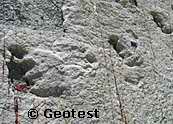 More than 5,000 huge footprints criss-cross a crumbling wall at a quarry near Sucre, Bolivia - the largest site of dinosaur tracks in the world.
More than 5,000 huge footprints criss-cross a crumbling wall at a quarry near Sucre, Bolivia - the largest site of dinosaur tracks in the world.
But Cal Orck'o, as it is known locally, is under threat from erosion. To secure the endangered site the Bolivian government has called upon Swiss expertise.
'It surpasses anything I've ever seen,' said palaeontologist Christian Meyer, the director of Basel's Natural History Museum, who led the first team of scientists to map the site in 1998...
...'If you compare Cal Orck'o with the biggest dinosaur sites in Australia, the United States, Asia or Europe, this is by far the largest,' Meyer told swissinfo.
'The diversity of dinosaurs from the late Cretaceous period is frozen in time, just before they became extinct.' [footprints, species]
technorati tags: sucre, bolivia, dinosaur, tracks, swiss, dinosaurs, geological, record, footprints, species, australia, united+states, asia, europe, diversity, cretaceous, extinct, cal orck'o
Add to: CiteUlike | Connotea | Del.icio.us | Digg | Furl | Newsvine | Reddit | Yahoo
Snapdragons take the evolutionary high-road
 Roses are red, violets are blue, but why aren't snapdragons orange? Norwich scientists from the John Innes Centre (JIC) and the University of East Anglia (UEA) in collaboration with the University Paul Sabatier (Toulouse, France) have developed a pioneering computer modelling technique that traces the evolutionary paths underlying flower colour variation in the model plant snapdragon (Antirrhinum).
Roses are red, violets are blue, but why aren't snapdragons orange? Norwich scientists from the John Innes Centre (JIC) and the University of East Anglia (UEA) in collaboration with the University Paul Sabatier (Toulouse, France) have developed a pioneering computer modelling technique that traces the evolutionary paths underlying flower colour variation in the model plant snapdragon (Antirrhinum).
Their research, funded by the BBSRC and published today in the journal Science ("Evolutionary Paths Underlying Flower Color Variation in Antirrhinum": Abstract), shows how flower colour diversity has evolved in natural populations of these plants in the Pyrenees.
In the wild, only the plants with the most attractive flower colours are able to reproduce and thrive because the insects that pollinate them prefer certain colours. The bees that pollinate snapdragon find magenta and yellow flowers the most attractive; they do not find colours such as orange attractive and so flowers of this colour would not flourish in the wild due to lack of pollination. Scientists already know that natural colour variation is controlled by three genes: ROSEA and ELUTA affect the intensity and pattern of the magenta pigment anthocyanin and thirdly SULFUREA affects the distribution of the yellow aurone pigment. The researchers in this study wanted to understand how plants producing magenta or yellow flowers could evolve from a common ancestor without producing in-between non-attractive flower colours such as orange.
"This is a totally different way of looking at evolution and could lead to a better understanding of the rules that govern biodiversity" explains Coen, "If we can comprehend how Antirrhinum genes interact in their natural habitat, it may help us in the future to better preserve genetic diversity".
technorati tags: Antirrhinum, snapdragons, university, east+anglia, sabatier, france, evolutionary, computer, modelling, flower, colour, color, variation, science, paths, diversity, plants, pyrenees, insects, pollinate, bees, rosea, eluta, sulfera, common, ancestor, evolution, biodiversity, genes
Add to: CiteUlike | Connotea | Del.icio.us | Digg | Furl | Newsvine | Reddit | Yahoo
New England site yields dino track (dilophosaurus)
Rocky Hill - A worker digging up bedrock in Connecticut unearthed a three-toed, fossilized dinosaur footprint that is thought to be from a dilophosaurus.
Glenn Korner was working with an excavator in Rocky Hill when he flipped over a large rock and found the dinosaur relic, the Connecticut Hartford Courant reported Saturday.
The dilophosaurus, literally a 'two-crested lizard,' was a 20-foot-long carnivorous beast that walked on two legs. [New England]
technorati tags: dilophosaurus, connecticut, bedrock, dinosaur, footprint, lizard, carnivorous, new+england, hartford
Add to: CiteUlike | Connotea | Del.icio.us | Digg | Furl | Newsvine | Reddit | Yahoo